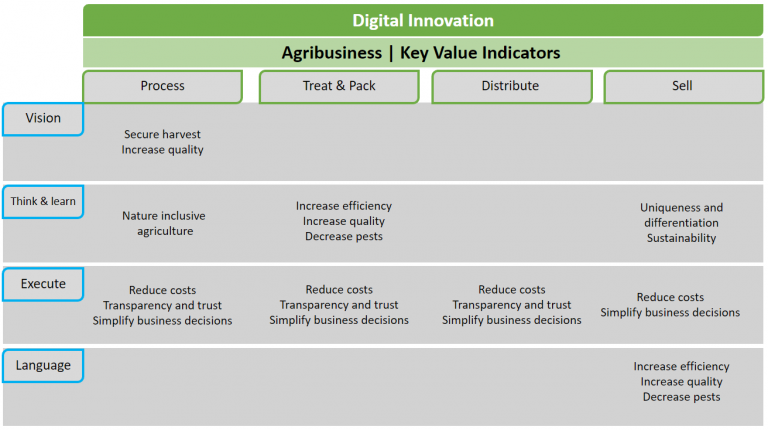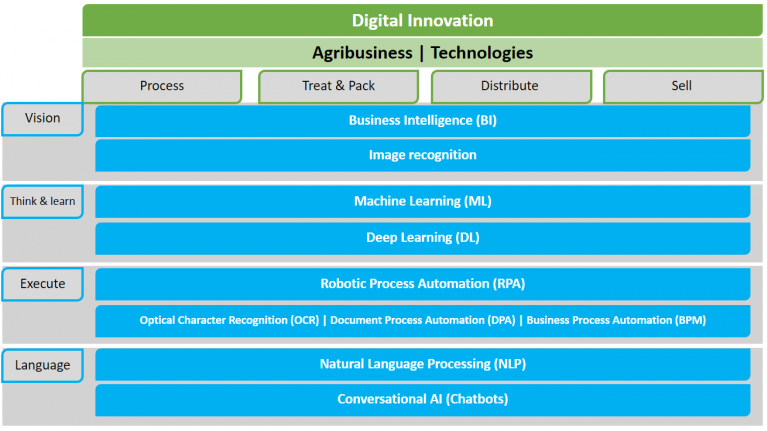Intelligent Automation As An Energetic Accelerator

Roel Hoeks, Co-Founder & Managing Partner at Roborana NL and EsperantoXL

Chris Vinke, Founder & CEO at GRN Consultancy BV
Acelerating climate change and the COVID-19 pandemic have brought a very important question to the forefront of our minds as a society. “How can the world nourish 9.8 billion people by 2050 through sustainable practices?” Food security is one of the most important components of a well-functioning society and so the leaders of great agribusinesses have a lot of responsibility. Our food systems, as they stand, do not currently provide nutritious food in an environmentally sustainable way to the world’s population. Nearly 800 million people are undernourished while 2 billion are micronutrient deficient, and 2 billion more are overweight or obese.
At the same time – food production, transportation, processing, and waste are placing tremendous strain on environmental resources. Change is needed. Due to a wide range of sub-optimal processes, the whole supply chain is struggling with ways to solve the nourishment challenge. What is clear though is that agribusinesses need to adapt their operations and behavior to be suitable to the modern world. They require radical digital transformation. And this needs to come right from the top. The key to successful digital transformation at the national level is to set the right direction through effective leadership, strategy, and investment models, while also scaling the transformation through finance, infrastructure, institutions, and monitoring’ (WEF, 2021).
The New Vision for Agriculture (NVA), defined by World Economic Forum partners in 2009, dictates that to meet the world’s needs; sustainable agriculture must simultaneously deliver food security, environmental sustainability, and economic opportunity. Achieving those goals requires a transformation of the agricultural sector, leveraging market-based approaches through a coordinated effort by all stakeholders, including farmers, government, civil society, and the private sector. Digital agriculture encompasses a wide range of technologies, most of which have multiple applications along the agricultural value chain. These technologies include, but are not limited to:
- Cloud computing and big data analysis tools Artificial intelligence (AI)
- Machine learning
- Intelligent Automation
- The Internet of Things
- Precision agriculture technologies
- Sensors (food, soil, etc.)
- Guidance and tracking systems (often enabled by GPS, GNSS, RFID, IoT)
One of the most exciting technologies that comes from this is that of intelligent automation, which can be utilized to lower the Total Cost of Ownership (TCO), speed up the Return On Investment (ROI), and simplify processes across the board. Due to the vast number of new tools available, the increasing demand for reduced packaging, optimized logistics, pressure on food supply chains, and the current epidemic turning the tide to reduce costs and keep operational margins as top priorities (Forrester, 2020). Automation, in general, has enabled and accelerated a significant increase in remote working and has addressed rapid growths in processing requirements. As an example, 23% of survey respondents said they have prioritized automation that improves their organizational resilience (UiPath, 2021).
Bridging the Gap Between Business & IT
This is not something that can be ignored. Whether you like it or not, the stakeholders who don’t upskill themselves and therefore lack knowledge of these new options are going to find themselves being left out of these important initiatives. Reskilling plans and revised role definitions that are based on how the human workforce will interact with machines should be baked into intelligent automation adoption plans. This change management is as important as the technology itself.
Workers should reimagine how they work from first principles. While substituting intelligent machines for human workers may reduce costs in some cases, you leave a lot of value on the table if you stop there. Mere automation does not necessarily translate into value and new meaning. You have to go above and beyond to imagine how this technology can augment your operations.
To capture the significant productivity gains that are there for the taking, these technologies need to work harmoniously together in order to deliver new work outcomes. Business leaders must push outside the boundaries of old process maps, looking beyond the limitations of currently used technology, and using automation to fundamentally transform the way that work gets done (Deloitte, 2020). This is especially true for utilities who have done things the same way for so long now. Fresh thinking is required, taking into account what technology we now have at our disposal.
Global Trends in Agribusines
Together Mode
As virtual interactions start to generate practical and aesthetic outcomes that have moral consequences and personal meaning, it begs the question about which things need be in the physical world at all. The idea that.
As we sit here in 2022, it seems selfevident that using RPA as a kickstart for your automation journey is a good way to go (McKinsey, 2020). However, it’s just a step along the journey. You must go further to get the outcome that you desire, pulling together semi and structured data in an efficient manner. RPA bots are essential for taking over transactional activities of various types. For example, offloading data entry or copying data across systems allows your employees to free up time and resources to focus on more strategic tasks.
RPA provides the transition from servicesthrough-labor to services-through-software. It’s clear that RPA represents a significant lever that you can pull to significantly improve efficiency, robustness, and product quality alike. It’s especially valuable when dealing with repetitive processes, high transaction volumes, and cost critical processesthe “tangible” world is limited to that which is physically present nearby will seem increasingly unusual in the years to come.
What, after all, is real, anyway?
Agribots
Using satellite positioning and other sensors, these bots can perform tasks that previously required manual interventions at a much higher level of accuracy and in a much cheaper way. These processes can therefore be scaled to a level like we’ve never seen by leveraging the work of these bots.
AI Adoption
A survey carried out by the Boston Consulting Group and MIT polled almost 2,500 managers and found that seven out of ten of them said their AI projects had generated little impact so far. Two-fifths of those with “significant investments” in AI had yet to report any benefits at all.
One is prosaic: businesses, particularly big ones, often find change difficult to deal with, and implement. AI experts are scarce and request luxuriant salaries (The Economist, 2020). It still remains to be seen what impact the technology is going to have on the industry as it develops, and companies figure out how to make it work in production.
Local Themes in Agribusiness
The major global themes, like AI adoption, Together mode and Agribots should be mapped to our Benelux context, although nuance and differences can be adjourned, we captured the similarities in figure 1, Key Value indicators.

The global and local themes seem to overlap. If the root causes of these challenges are investigated properly, we’re likely to see that intelligent automation could open a lot of doors to help solve for these problems. Due to the emergence of software robots at a reasonable cost and capability; Robotic process automation (RPA), process analysis, process modelling, process improvement, and even business process management tools (BPM) have received a tremendous boost in their ability to transform organizations. However, when we consider RPA as a software application, the automation of mundane tasks alone will not be enough (HFS, 2019).
In 2021, it seems evident that using RPA as a catalyst for the automation journey is the right way to go (McKinsey, 2020). However, there is much more needed to get you the outcome that you need, especially when it comes to semi and structured data. We structured all the solutions in Figure 2.

You put your agricultural organization at risk when you embed business logic into hand-coded applications because these tend to be cumbersome and slow down your ability to be agile and rapidly respond to future changes.
Bridging the Gap Between Business & IT with Intelligent Automation
Moreover, stakeholders who lack the requisite knowledge of these new options to enhance efficiencies will tend to be left out of these important initiatives. Reskilling and revising role definitions that are based on how the human workforce will interact with machines should be baked into intelligent automation adoption plans from the beginning. However, the idea should not end there. Workers should redesign and organize how they work to be relevant in this new age.
Merely deploying automation and substituting intelligent machines for human workers may reduce costs, but it will not necessarily translate into value and new meaning. Real strategic direction is required as well to bring this vision to fruition. To capture the significant productivity gains that are available, technologies need to work in concert with one another to deliver new work outcomes. Work must be reimagined by business leaders who are pushing outside the boundaries of traditional process maps, looking beyond the limitations of currently used technology, and using automation to fundamentally transform the way that works gets done (Deloitte, 2020).
RPA: Remember that RPA is still a crucial part of Intelligent Automation
RPA bots are essential for taking over transactional activities of all kinds. For example: handing off data entry tasks or copying data across systems will free up time that allows your employees to focus on more strategic tasks. RPA provides the necessary transition from services-through-labor to services-through-software. RPA is a significant lever that can be pulled to increase process efficiency, robustness, and product quality. Its applicability is most evident when we consider repetitive processes, high transaction volumes, and cost critical processes. Some of those might include the following:
- Providing managed services that increase efficiency
- Optimizing assets to reduce emissions and consumption
- Leveraging data and providing insights to dive sustainable performance
Orchestration: This step automatically coordinates and manages computer systems, middleware, and services as part of a larger workflow. This means that a person is notified if there’s a transaction that a bot cannot process. This proactive nature is really helpful for getting the most out of your automation efforts.
Combining orchestration with RPA in this way creates flexible, long-lasting solutions and bots that can self-manage exceptions. To get even more insights and validate the business value of the Intelligent automation project further, process mining can also be leveraged.
Intelligent Automation in Action at Agristo
Agristo is a global player in the development and production of frozen potato products. It deals with everything that has to do with potatoes. To be able to focus even more on its core competencies, they decided to start implementing Robotic Process Automation (RPA) into their business. In this way, Agristo gains time and increases the satisfaction of its employees, without affecting the client experience.
Originality and Innovative Power of the Project
While most companies mainly pay attention to the business impact that RPA delivers, Agristo invests in RPA because it helps to maintain and increase employee satisfaction. When they feel more fulfilled and productive at work, this trickles down to the end consumer. The CIO of Agristo, Martijn Mennen, actually listens to his business stakeholders and takes them seriously.
He believes that the road to higher efficiency and productivity starts internally and then, in the long term, it will also pay off externally. That’s why Agristo chose, for example, to automate a process that only occurs once a month. The internal invoicing and analysis of their fixed active assets must take place during a peak period for Aristo’s financial service – putting extra pressure on the team during an already stressful period. Now that the process is automated, employees have less stress and higher satisfaction at work. The ROI might seem limited because ‘only’ one day of work is saved every month. But on the other hand, Agristo has more satisfied employees throughout the month who can invest their energy in their core tasks.
Roborana’s different solutions
Our tool-agnostic approach provides a rich set of application development tools and best practices designed to capture business requirements, build business logic, and transform how the operations have been done for years at lower risk and costs. We are passionate about bringing this power to clients and fitting seamlessly into their existing workflows. Create bots in minutes instead of months or years by working with a professional firm that has the experience and expertise that you can leverage. We’ve seen the good, the bad, and the ugly – you don’t have to make those same mistakes. Let’s talk.
Roborana NL is a Robotic Competence Center, part of Cronos Group and EsperantoXL. We help organizations to embed virtual workers and to automate repetitive processes.
Vision of GRN
In 3 years we want to have done our part for the 2050 goal of feeding the world with digital solutions, robotization, automation and AI & IoT. By helping to reduce waste, increase efficiency and embrace the transition of a circular world. Starting small, our 90-day plan is the first step in the right direction. What we need is support from our potential partners to make the journey and make them more digital with our Intelligent Automation, conceptualization and training.